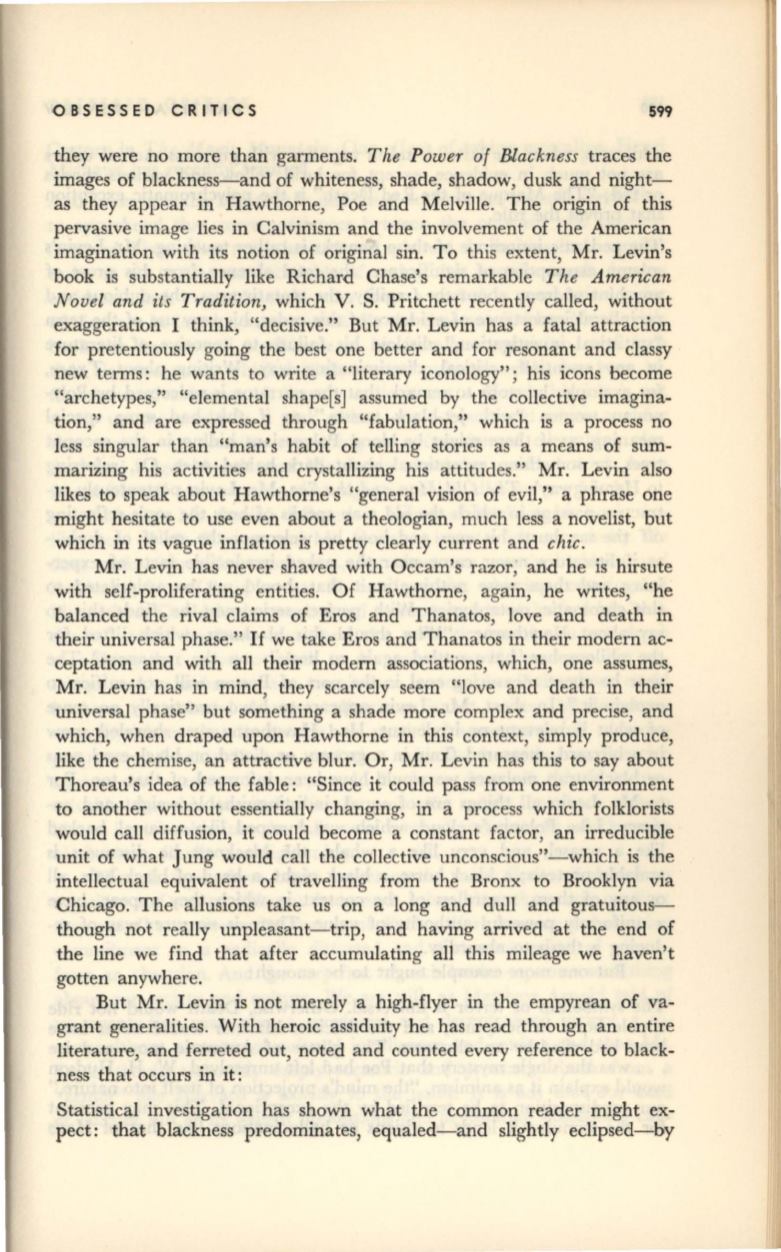
OBSESSED CRITICS
599
they were no more than garments.
The Power of Blackness
traces the
images of blackness-and of whiteness, shade, shadow, dusk and night–
as they appear in Hawthorne, Poe and Melville. The origin of this
pervasive image lies in Calvinism and the involvement of the American
imagination with its notion of original sin. To this extent, Mr. Levin's
book is substantially like Richard Chase's remarkable
The American
Novel and its Tradition,
which V. S. Pritchett recently called, without
exaggeration I think, "decisive." But Mr. Levin has a fatal attraction
for pretentiously going the best one better and for resonant and classy
new terms: he wants to write a "literary iconology"; his icons become
"archetypes," "elemental shapers] assumed by the collective imagina–
tion," and are expressed through "fabulation," which is a process no
less singular than "man's habit of telling stories as a means of sum–
marizing his activities and crystallizing his attitudes." Mr. Levin also
likes to speak about Hawthorne's "general vision of evil," a phrase one
might hesitate to use even about a theologian, much less a novelist, but
which in its vague inflation is pretty clearly current and
chic.
Mr. Levin has never shaved with Occam's razor; and he is hirsute
with self-proliferating entities. Of Hawthorne, again, he writes, "he
balanced the rival claims of Eros and Thanatos, love and death in
their universal phase."
If
we take Eros and Thanatos in their modern ac–
ceptation and with all their modern associations, which, one assumes,
Mr. Levin has in mind, they scarcely seem "love and death in their
universal phase" but something a shade more complex and precise, and
which, when draped upon Hawthorne in this context, simply produce,
like the chemise, an attractive blur. Or, Mr. Levin has this to say about
Thoreau's idea of the fable: "Since it could pass from one environment
to another without essentially changing, in a process which folklorists
would call diffusion, it could become a constant factor, an irreducible
unit of what Jung would call the collective unconscious"-which is the
intellectual equivalent of travelling from the Bronx to Brooklyn via
Chicago. The allusions take us on a long and dull and gratuitous–
though not really unpleasant-trip, and having arrived at the end of
the line we find that after accumulating all this mileage we haven't
gotten anywhere.
But Mr. Levin is not merely a high-flyer in the empyrean of va–
grant generalities. With heroic assiduity he has read through an entire
literature, and ferreted out, noted and counted every reference to black–
ness that occurs in it:
Statistical investigation has shown what the common reader might ex–
pect: that blackness predominates, equaled-and slightly eclipsed-by


